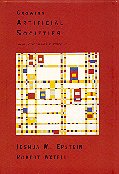'Sugarscape' is an application of the ideas from complexity theory and Artificial Life to the Social Sciences. The goal is to see if the kind of behaviours seen in real societies can be modelled using just simple local rules, as suggested by these new disciplines. Unlike classic economic and social science theory, there is no need to assume that agents have perfect knowledge, that the population is homogeneous, or that an equilibrium has been reached. With a 'bottom up' model, the agent population can be highly heterogeneous, and highly dynamic.
So Sugarscape is an incredibly simple model of agents living, interacting with their environment by searching for and eating sugar and causing pollution, interacting with each other by sex, trade, war, and disease, reproducing, and dying. Despite the almost ludicrous simplicity of the models, the resulting behaviour can be surprising, marvelously complex, and even 'realistic'. As much behaviour as possible is allowed to 'emerge', rather than be programmed in. Crucially, there is no static externally-imposed fitness function: fitness is simply the measure of how well the agents survive in a varying environment:
The models start off at about the simplest possible, and throughout the book more parameterised properties are added, both to the agents (for example, vision acuity, sex, inherited wealth) and the environment (for example, 'seasons', pollution diffusion), and extra complexity in the behaviour is observed, varying qualitatively with the parameters. For example, in an early model, just varying the mean life expectancy parameters yielded steady state populations, oscillating populations, and extinctions for otherwise identical models:
Various interesting properties of the models can be seen. A 'natural' imbalance occurs in the distribution of 'wealth' (amount of sugar), even when there is no direct competition for the resource (no war or trade). Inheritance (unsurprisingly) magnifies this inequality, and reduces the selection pressure, and hence the 'fitness' of the population (as measured by the mean vision acuity). In other words: short-sighted rich kids survive more easily.
In later chapters the models get progressively even more complex. Trade is added to the equation by having a second commodity, 'spice', that different agents metabolise at different rates from the sugar. So agents are willing to trade sugar for spice, at different prices depending on their need for and current quantity of each. Trade increases the number of agents the Sugarscape can support, but also increases the inequalities of wealth. The authors use their results to take the opportunity to snipe at laissez-faire economic theory, but don't have anything bad to say about the other end of the spectrum: total centralised control: but maybe that's a given? This chapter assumes a lot more knowledge of economics than I have -- terms like Walrasian Equilibrium and Cobb-Douglas functional form are bandied about with little explanation in the analysis -- but what the models are doing is still perfectly clear.
The final step to adding more behaviour is model of disease transmission and immunity that is interesting in its own right. One important property this model has is that diseased agents have different behaviour from healthy agents: a property surprisingly missing from many classical epidemiology models.
These later chapters are quite fascinating because they make clear the enormity of the parameterised problem space being opened up, but unfortunately the topics are treated too briefly for my liking: I would have like the book to have been about twice as long as its rather slender 200 pages. I suspect the authors may not yet have had time to do enough exploration and analysis to come up with a rich set of results. But the feeling of the complex, non-linear, non-equilibrium behaviour of agents coevolving with their environment is very well conveyed. I was left feeling a little daunted by the sheer complexity of the parameter spaces -- will it ever be possible to have a good understanding of such systems? An understanding good enough that we might be able to make small local changes that have the desired global effects?
But you don't have to stop when the book finishes. If you want to carry out your own experiments, the Sugarscape software is available on CD. I certainly intend to get a copy.
